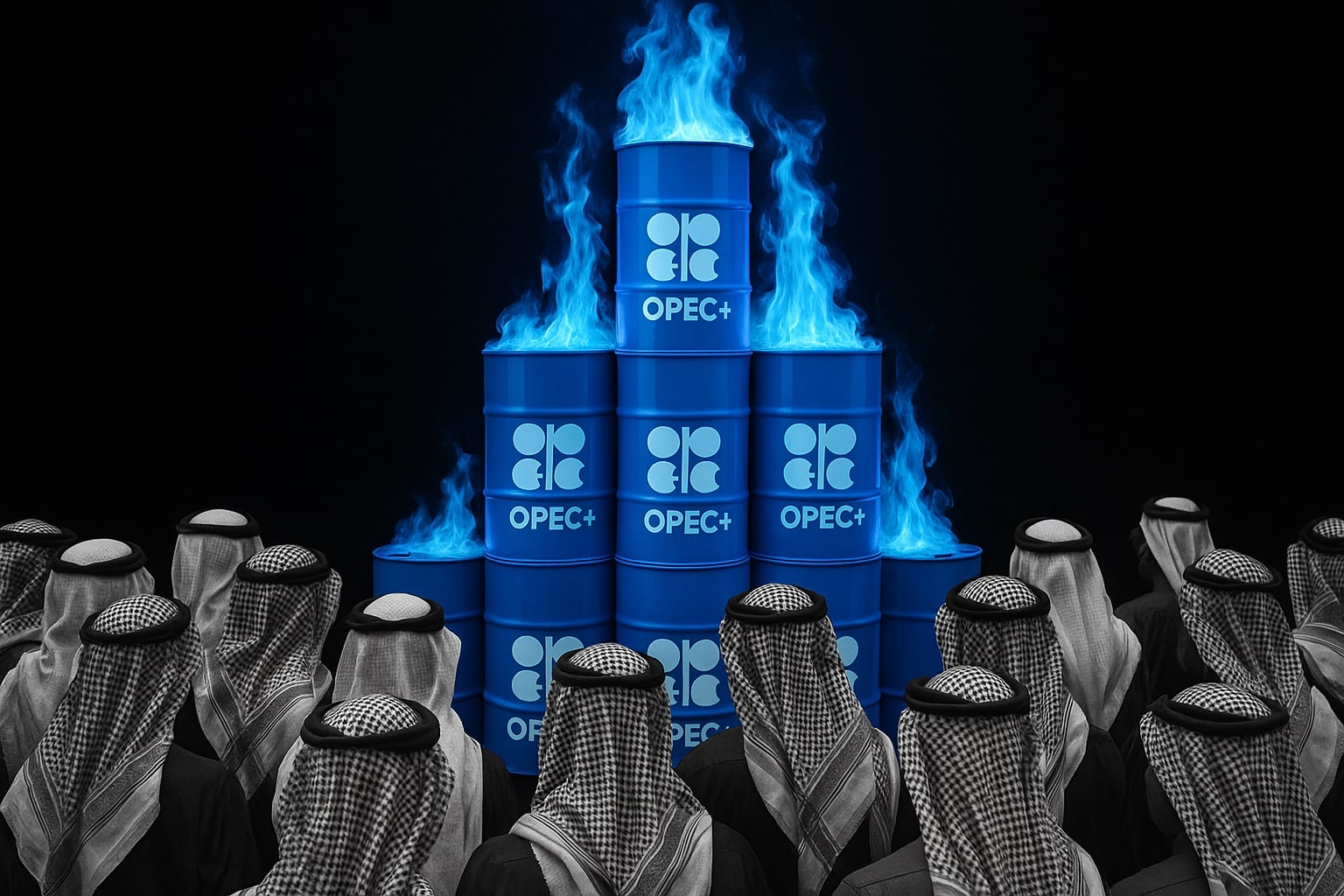
Oil Price Forecast - Oil Prices Drop to $59.75 as U.S. Inventories Surge 5.2M Barrels
WTI (CL=F) slips below $60 despite OPEC+ restraint; Brent (BZ=F) holds $63.63 as Saudi price cuts, China’s slowdown, and U.S. oversupply pressure markets | That's TradingNEWS
WTI Crude (CL=F) Slides to $59.75 as Inventories Surge and Global Demand Falters Amid U.S. Shutdown Shock
West Texas Intermediate (WTI Crude, CL=F) traded at $59.75 per barrel, down 2.02% for the week, reflecting the sixth consecutive weekly loss as the U.S. government shutdown drags into its sixth week and global demand indicators continue to weaken. Brent (BZ=F) also slipped to $63.63, while Mars US crude dropped to $70.71, and Bonny Light plunged 2.84% to $78.62, highlighting a synchronized retreat across benchmarks. The data reveal that structural oversupply and eroding consumption are overpowering OPEC+ efforts to stabilize prices as 2025 nears its close.
U.S. Supply Glut Deepens as Inventories Jump by 5.2 Million Barrels
According to the Energy Information Administration (EIA), U.S. crude inventories rose by 5.2 million barrels in the latest week, bringing total stockpiles to 421.2 million barrels. This marks the second consecutive build after the American Petroleum Institute (API) shocked traders with a 6.52 million barrel rise a week earlier. The accumulation reflects both record U.S. production and soft refinery utilization rates—refiners ran below 87% capacity amid weak gasoline margins and seasonal maintenance.
U.S. crude production remains at a record 13.8 million barrels per day (bpd), extending its lead as the world’s largest producer. This level, combined with tepid domestic consumption, has offset disruptions elsewhere—from Kazakhstan’s 10% output decline due to Tengiz maintenance to continued Libyan field outages. The result is a domestic oversupply that has crushed prompt-month WTI contracts below $60, the lowest since May.
OPEC+ Price Strategy Fails to Contain Market Surplus
OPEC+’s latest policy adjustment—a 137,000 bpd increase in output for December while pausing further hikes—has failed to impress markets. Traders view the decision as reactive rather than strategic, particularly after Saudi Arabia slashed official selling prices to Asia for the first time in six months. The price cuts, averaging −$0.40 to −$0.70 per barrel, signal waning regional demand and a battle for market share against discounted Russian Urals and Iranian blends.
The OPEC basket price, at $65.51 (+0.12%), remains near the bottom of its three-month range, reflecting muted physical demand. Meanwhile, floating storage has surged globally, with Indian ports hosting redirected Russian cargoes following renewed U.S. sanctions. Traders now monitor whether the upcoming December OPEC meeting will introduce deeper cuts beyond 1.6 million bpd or risk further price erosion toward the $55 support zone.
Weak Global Demand: China, Japan, and Europe Slow Simultaneously
Demand deterioration remains the most persistent headwind. China’s manufacturing PMI contracted for the seventh straight month, barely holding at 49.7, while Japan’s PMI fell to an 18-month low. Freight data confirm weaker mobility—global shipping volumes are down 6.4% year-on-year, and U.S. gasoline demand slipped 1.9% week-on-week according to EIA consumption data.
JPMorgan revised its 2024 oil demand growth forecast down from 900,000 bpd to 850,000 bpd, underscoring a structural slowdown. Even though China’s crude imports rose 2.3% month-over-month in October due to refinery restocking, these purchases are driven by opportunistic buying at low prices rather than genuine consumption recovery. In Europe, industrial output fell 0.3% m/m, confirming continued contraction in fuel-intensive sectors such as chemicals and steel.
Geopolitical Friction Adds Noise but Limited Support
Political events continue to influence market psychology without producing sustainable price recovery. The U.S. government’s potential exemption of Hungary from Russian oil sanctions introduced fresh uncertainty about the integrity of Western supply coordination. Meanwhile, Trump’s proposed energy reshoring incentives have raised questions over whether the U.S. could further expand drilling capacity in 2026, aggravating the supply glut.
At the same time, Iranian and Russian tankers continue to use transshipment points off the Indian coast to bypass sanctions. While these clandestine movements attract headlines, their actual contribution to market balance is marginal compared to the unrelenting growth in U.S. production.
Technical Breakdown Confirms Persistent Bearish Channel
Technically, WTI (CL=F) continues to trade within a three-year descending channel, maintaining lower highs and lower lows since mid-2022. Prices are hovering near the mid-zone of both the long-term downtrend and the five-month short-term channel, with clear support near $59.44 (the 0.618 Fibonacci retracement) and major resistance around $63.00–$66.80.
Failure to hold the $59 level would expose the $55.96 swing low, last tested in March 2023, and could extend toward the $49.00 psychological floor, where structural support from long-term hedgers is expected. Conversely, a confirmed weekly close above $63.00 could lift prices toward the upper boundary near $70.00, aligning with the 200-week moving average—a key signal for any sustainable reversal.
Broader Market Sentiment: Energy Equities and Refining Margins Under Pressure
The slump in crude prices has filtered into energy equities and refining margins worldwide. ExxonMobil (NYSE:XOM) and Chevron (NYSE:CVX) both lost more than 4% week-to-date, while integrated majors such as BP (LON:BP) and Shell (LON:SHEL) face margin compression due to narrower crude differentials.
Refining crack spreads in Singapore fell to $6.20/barrel, the lowest since 2020, while U.S. Gulf Coast diesel cracks narrowed below $10, signaling reduced profitability. Downstream operators like Petrobras (NYSE:PBR), despite record production at the Búzios field, are cushioning declines through dividend hikes, maintaining payouts above 12% annualized yield. However, persistent weakness in global product margins implies that even high-volume producers are prioritizing shareholder returns over new exploration.
Read More
-
PFFA ETF Nears $21.50 as Rate Cuts and 9.49% Yield Spark Renewed Demand
29.11.2025 · TradingNEWS ArchiveStocks
-
XRPI and XRPR ETFs Ignite Ripple’s Institutional Rally as Inflows Near $1B and XRP Holds $2.20
29.11.2025 · TradingNEWS ArchiveCrypto
-
Natural Gas Price Forecast - NG=F Blasts to $4.85 as Demand Surge Fuel Multi-Month Breakout
29.11.2025 · TradingNEWS ArchiveCommodities
-
USD/JPY Price Forecast - Yen to Dollar Slides to 156.10 as Yen Strengthens on Fed Cut Expectations
29.11.2025 · TradingNEWS ArchiveForex
Natural Gas and Related Commodities Follow the Slide
The energy weakness extends beyond crude. Natural gas (NG=F) dropped 0.96% to $4.315/MMBtu, reflecting warmer weather and high storage levels across Europe and the U.S. Meanwhile, gasoline futures (RB=F) slid 1.29% to $1.940 per gallon, emphasizing the broad-based demand fatigue. The decline in Louisiana Light (-0.10%) and Mars US (-1.34%) further illustrates how localized benchmarks are tracking the global downturn rather than diverging from it.
Ongoing Sanctions, Production Adjustments, and Corporate Developments
The market also digests a stream of supply-side news. Kazakhstan’s October output dropped 10% due to Tengiz field maintenance, Iraq canceled Lukoil cargoes under U.S. pressure, and Gunvor withdrew from a Lukoil acquisition after the U.S. Treasury labeled the firm a “Russian puppet.” Despite these geopolitical shifts, the net impact on supply remains limited—each disruption is countered by stronger North American output and incremental increases in Canadian Natural Resources (TSE:CNQ) and Cenovus Energy (TSE:CVE) production, both of which hit record highs.
Elsewhere, Dana Gas (ADX:DANA) added 21.3 billion cubic feet (bcf) of new gas reserves in Egypt during the first nine months of 2025 under its $100 million investment program, reinforcing the Middle East’s pivot toward gas expansion amid oil price volatility.
Market Psychology and Positioning: Hedgers Increase Shorts
CFTC data indicate that commercial hedgers increased net short positions in WTI by 8.2%, while managed money accounts cut longs by 11%, marking the steepest liquidation since July. Open interest across CME crude futures remains elevated but risk appetite has diminished; implied volatility climbed to 31%, up from 27% two weeks prior.
Retail sentiment remains skewed to the long side, with 61% of traders net-long WTI, a contrarian bearish indicator suggesting more downside before a potential rebound. Institutional desks describe current price action as “technically oversold but fundamentally justified.”
Broader Macro Context: Shutdown Paralysis and Economic Deceleration
The U.S. government shutdown, now exceeding six weeks, has frozen data releases for nonfarm payrolls and CPI, limiting visibility on macro trends. The absence of official guidance has heightened uncertainty across all commodities, while AI-related layoffs and reduced freight traffic reinforce fears of decelerating demand into 2026.
With the Federal Reserve’s last 25 bps rate cut failing to lift risk sentiment, global markets are now pricing in lower oil demand elasticity. Yield curve inversion persists, and the S&P 500 energy sector has underperformed the index by 7.8% year-to-date.
WTI (CL=F) and Brent (BZ=F) Forecast: Downside Risks Dominate
Both benchmarks face near-term resistance within the $63–$67 range and support between $55 and $59. Without a clear catalyst—such as a meaningful OPEC+ supply cut or a geopolitical shock—momentum favors consolidation with downside bias. Seasonal trends, refinery turnarounds, and the potential resumption of U.S. data publication in December could inject short-term volatility, but the medium-term trajectory remains capped by excess supply and weakening consumption.
WTI’s structural pivot hinges on whether the U.S. can slow production growth below 13 million bpd or if OPEC+ enforces coordinated discipline across its members. Brent’s premium to WTI, currently $3.88, may widen if European demand stabilizes faster than U.S. consumption.
Final Assessment on Crude Oil (WTI CL=F / Brent BZ=F) — SELL (Short-Term Bias: Bearish Continuation)
The data confirm a deepening supply imbalance reinforced by weak macroeconomic demand. Elevated inventories, stagnant refinery throughput, and ineffective OPEC+ policy make a short-term recovery unlikely. The prevailing structure remains bearish as long as WTI trades below $63 and Brent below $67.
Traders should expect volatility spikes near the $55–$49 support corridor, where long-term hedgers may reemerge. Until then, the prudent stance is SELL on rallies, with potential downside targets near $55.00–$49.50 and only limited upside toward $66–$70 under favorable sentiment shifts.
The oil market’s tone entering late 2025 is defined not by crisis, but by saturation—a world awash in barrels and searching for demand that has yet to return.
That's TradingNEWS



















